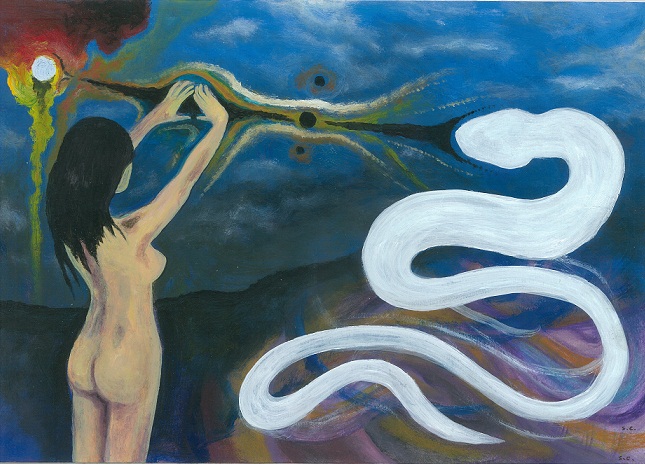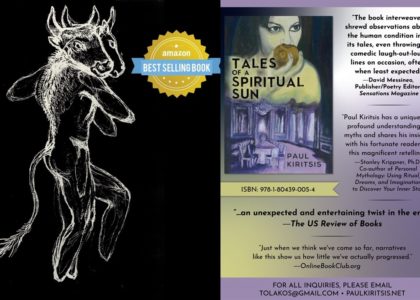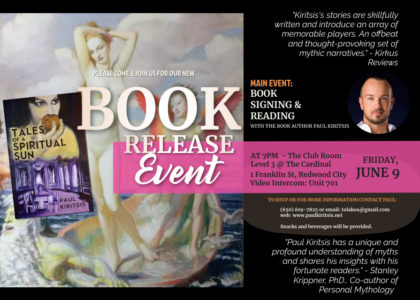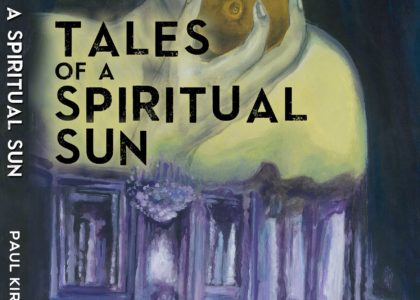
Part 1: Oral History and Myth
History in the written form has only been around for about five thousand years, since the evolution of Mesopotamian script known as cuneiform and Egyptian hieroglyphic picture writing. History as we know it has also been recorded only by those who can write, mostly educated men until late, each with their own biases and opinions. What does this mean? Quite simply that the written records are quite like the pages of a book. Some have been scrunched, some ripped, and others torn from the book completely. In some cases, the ink has either smudged or what has been recorded is soaked with anything but the truth. The record of history is far from complete and in some instances, the truth.
Taking into careful consideration that human beings have been around for about five million years, it is quite ridiculous to think that the physiological growth of the human brain which paved the way for the evolution of consciousness has occurred only since the advent of the written word. In actual fact, it is not only probably but likely that humans had already developed a deep understanding of the cosmos many thousands of years before the first hieroglyph was ever carved in stone. Before the advent of writing, oral tradition was the only way that all forms of folklore–myths, legends and folktales–could be communicated between members of the same community. These prose narratives were often told by a people about themselves and soaked in the subjective appeal of local history. They concerned themselves with great folk epics, sagas, heroic legends and balladry. This narrative form was an unreliable source of knowledge, often distorted and changed as it passed on from generation to generation (think Chinese whispers). The notion that it was firmly routed in the psyche of people belonging to all social divisions and not just to those of the upper class allows for a more accurate evaluation of the cultural views and values of its particular time. Oral tradition speaks for the masses, not only the select few. We live out our everyday lives with speech, not writing.
With the arrival of speech came the faculty of religion, a force that would pave and shape our historical past. Religion would also dictate the continual evolution of individual and collective consciousness. The belief in a higher order of things has always been so firmly rooted in the psychology of humanity that it is almost impossible to pinpoint with any accuracy what prehistoric deities existed, in what form they were imagined, or with what ritualistic method they were venerated. This might tempt one to question from whence the major principles of religion evolved. The answer is quite simple–the sky. The first tribal peoples would have been awe-inspired and completely obsessed with this facet of nature which occupies so much of the visual world which appears impenetrable and beyond comprehension. The dynamic forces of nature at work–wind, heat, cold, thunder, and lightning–would have been perceived as influencing one another and, more importantly perhaps, the events down on earth. Natural phenomena would have greatly affected the fate of early nomadic people who did not possess the practical knowledge for the construction of nearly-impenetrable edifices that we do today. In addition, the two great lights moving through the sky, the sun and moon, as well as the stars and planets, would have greatly impressed early sky watchers. After careful observation, certain recurring patterns would have been observed in the night sky in juxtaposition to its more unpredictable behaviour during daytime. If the sky held within it the power to influence events down here on earth, would it not be reasonable to assume that it held considerable influence over personal fate as well?
This enduring fascination with the sky led to the birth of astrology, the study of the effect of the heavenly bodies on human fate. In prehistory, this celestial protoscience, astronomy, and mythology were virtually inseparable. The sky became the home of the many gods and goddesses that would grace the pantheon of every pagan religion (i.e. the Greek gods lived on Mt. Olympus) prior to the arrival of the monotheistic movement heralded by Akhenaten in Pharaonic Egypt, and upheld by the doctrine of the Hebrew god Yahweh and Christianity in late antiquity. The primitive mind was quite unsure of how these deities who ruled over earth and heaven could be pacified or coerced. Ritualistic and superstitious behavior was born–sacred dances, chants, animal, human sacrifices–and performed on consecrated areas in hope that the laws of nature could be infringed for the better. These rituals were impossible to separate from the religious doctrine they were used to uphold and passed on from one shaman or priest to the next and from generation to generation in an unbreakable chain associated with ancestor worship. Magical ritual often involved priests falling into trance-like, hypnotic or hypnagogic states. They were also portrayed as having existed for time immemorial and handed down from the gods themselves. The shamans of individual communities became authoritative forces to be reckoned with when it came to political influence, as they were the only ones who could commune with the divine powers above. The oracle at Delphi in Classical Greece given by the Pythia of Apollo, the First Prophet of Amun at Thebes in Pharaonic Egypt, and the Pope of the Roman Catholic Church at the Vatican City are three of the finest examples of secular power held by the priesthood of state.
Primitive ritual was closely associated with the explanation of natural phenomena and to effectively bridge the gap between the two, the verbal arts were born in the form of story-telling. These first myths spoke of creation and the reason for being. Most of them were closely associated with what the primitive individual or group perceived as important. Most early tribes placed agriculture at the heart of their world and rituals were conducted by priests in and around the times of sowing and harvest. Egypt provides the first instance of this. On the island of Philae in Upper Egypt, the god Osiris was originally venerated as the spirit of corn whom died in winter but come summer would be raised from the earth or “spring from the returning waters” of the great Hathor. This predynastic mother goddess was seen as a personification of the Nile. The events recurring down on earth were seen to be the lesser counterpart of those in heaven. The heaven of the gods and the earth of the mortals, two distinctly different realms, could now commune with one another through magic and ritual, sanctifying the same cyclic events of birth, death and continued existence into the afterlife.
Part 2: The Surviving Written Records of the Mythological Past
Before a discussion of Egypt’s mythological past can be presented, a clear distinction between the three major categorizations of prose narrative–myth, legend and folktale–must be made.
Myths are quite simply sacred narratives set in a time before the present; often before the creation of the world as we know it occurred. The word ‘myth’ is derived from the Greek ‘mythos,’ denoting word or story. Often enough, they are stories that are held to be true, told by the traditional elders of a particular culture about their own culture, and speak of a very distant past. They offer explanations and recount activities surrounding the origin of the universe and all things, living or animate, lying within. Some also embody dogma and function as authoritative sources for theology and ritual. Myths can be interpreted on many different levels. They can be viewed from an evolutionary standpoint as necessary precursors to scientific development or alternatively, they might be psychological metaphors revealing hidden spiritual truths. Others take a more anthropological stance, seeing them as projections of human dilemmas and drives relevant to a culture at any one particular time.
Legends are also prose narratives that belong to a long ago past although unlike myth, they are set in remembered or historical time, presented as undisputable truth, and are more secular than religious (Atlantis, King Arthur, the Holy Grail, the Mary Celeste, Loch Ness and the Fountain of Youth). They often concern themselves with matters of dynastic succession, migration, war and heroic quests which might contain elements of truth but are largely obscured by unverifiable aspects like hidden treasure and the supernatural. They are not as dynamic as myths because they do not demand unconditional belief from readers who might only take parts of the legend to be true or historically accurate. The legend serves to develop relationships between concrete, historic or topographical fact and the unknown world of the supernatural, striving to convince us of an event as having occurred.
Folktales are prose narratives that are fictional tales and invented by individual people. They are more often than not communicated orally, have no religious or sacred content and might concern themselves with magic, enchantment, monsters, and talking animals. No aspect of these stories carries or pretends to impersonate truth. Many cultures have established formulas with which they communicate them. Fairy tales, a subcategory of folktales, commonly open with ‘Once upon a time…’ and end with ‘…lived happily every after.’ The folktale serves to communicate morals or from a Jungian standpoint, bring together archetypal opposites and unveil unconscious psychological patterns that may be at the heart of psychospiritual development (i.e. individuation or self-actualization).
Ancient Egypt seems to provide us with the first instance of recorded folklore in the form of myth. These written records, deeply religious and funerary in nature, date back to Egypt’s Old Kingdom, (c.2686-c.2181) and are known as the Pyramid Texts. All human societies have stories of creation interwoven into their mythologies. Most of these describe how the universe and everything around us came to be. The setting is usually a flood of considerable proportion. In Ancient Egypt, creation myths surfaced before the complex relationships between Predynastic gods like Osiris, Horus, Hathor, Seth and Khnum evolved. The theogonies which propagated the most powerful of these were that of Ptah at Memphis, Thoth at Hermoupolis Magna, Atum at Heliopolis, and Khnum at Elephantine. All of these myths imagine the beginning as having been born out of an endless stretch of primeval ocean called Nun, with the patron of each city seen as the divine autocreator of the world.
In the Memphite version, Ptah conceived all aspects of the universe in his heart and brought it into being by speaking his thoughts out aloud. The Ancient Egyptians believed that the heart was the seat of not only emotion, but wisdom and thought as well. The power of creation inherent in thought manifesting as words, called ‘Logos’ in the biblical New Testament, was very important to Ancient Egyptian mentality throughout the duration of their history. In the Heliopolitan version, Atum, the solar creator god, appeared from the watery chaos and spat out (in some versions he masturbated) air, personified as the god Shu, and moisture, personified as the goddess Tefnut. In turn, Shu and Tefnut united to bear Geb and Nut, the earth and sky. From the union of these two came Osiris, Isis, Seth and Nephthys. Together, these nine gods were known as the divine Ennead of Heliopolis. The Elephantine version states that Khnum created the gods and mortals on his potter’s wheel. Alternatively, the creation myth of Hermoupolis Magna asserts that the Isle of Flame arose from the primordial waters of chaos. Thoth placed the cosmic egg onto the earth, which hatched to reveal a solar orb that proceeded to climb to the mount of the heavens. A variant of this myth narrates that a lotus flower rose from the watery chaos and blossomed to reveal the sun-god Re-Horakty (Re and Horus have merged into one deity here). These creation myths are all variants of the same concept; the state of order as we known it being established out of chaos. Each one gained the ascendancy when its cult centre became the focus of Egypt’s political and religious administration.
Part 3: Ancient Egyptian Folklore
Those sages who foretold the future, that which came forth from their mouths took place….They are gone, their names are forgotten. But writings cause them to be remembered.
From Papyrus Chester Beatty IV, translated after A.H. Gardiner
It may be said that in comparison to the Hellenistic poets and playwrights Homer, Aeschylus, Sophocles, and Euripides, and great thinkers like Plato and Aristotle, Ancient Egypt did not foster literary greats although it produced equally great literature which remains relatively unknown to modern audiences. It is possible that many writers of the ancient world had access to much of this literature as the story of the Trojan horse in the Iliad and the Tale of Ali Baba and the Forty Thieves bear striking resemblance to the capture of Joppa (modern Jaffa in Palestine) by Thutmose III who introduced baskets concealing soldiers into the town under the pretense of a gift. The literary compositions of archaic Egypt were wholly or partly preserved on papyri and ranged from narratives and tales, to instructional wisdom teachings and poetry. It is probable that religious motifs like the dying and resurrecting god, the trinity, duality of being in the guise of good and evil, and the triumphs of truth over falsehood; magical and alchemical motifs like protective amulets, the power inherent in one’s name giving control, mystic metallurgical practices, and the casting of spells; and symbolic motifs centred around colours, trees, plants, flowers and animals all had their origins in the folklore of Egypt, and are the remnants of a potential mass of unrecorded oral myth.
The known tribulations of Isis and Osiris, the greatest myth and first love story to propagate from Egypt, was never recorded because it was so heavily embedded in the hearts of all Ancient Egyptians. Our knowledge of it comes from the Greek writer Plutarch (c. ad 46-126) who transcribed it millennia after it was first told by prehistoric story-tellers. This myth may or may not carry historic, factual information. In Peri Isidos kai Osiridos, Plutarch relates how Osiris, the beneficent god, once ruled over Egypt with his sister-wife, Isis, bringing culture and civilisation to cannibals and barbarians who settled along the Nile Delta. Seth, their evil brother, grew jealous of Osiris’s fame and fortune and hatched a treacherous plot with seventy-two associate conspirators. He threw a party for Osiris and suggested to all present that they should play a game which involved a chest. The winner, claimed Seth, would be the individual who could fit perfectly inside the container. Not surprisingly the dimensions had been custom-tailored to the weight and size of Osiris, and so when the benevolent god opted to try his luck by climbing inside, all Seth and the conspirators had to do was slam the lid shut before he could lift himself out. Once the deed had been done, they hurled it violently into the Nile. Lamentably Osiris drowned during the ordeal and the coffin, now entangled in the roots of a tree, was carried by the current down to the Lebanese port of Byblos where it was fished out and used in the construction of the royal palace. Isis, lamenting her husband’s death, proceeded to hide her infant son Horus in the Delta marshes before going to search for him. She revealed her magical powers to the king and queen of Byblos who were so impressed that they offered to gift her anything in their household. To their surprise, Isis chose a pillar of wood that held up part of the palace complex.
Upon returning to Egypt, she hid the coffin in the Delta marshes while going to collect her son. But Seth found it whilst he was out hunting for wild animals and cut up the body into fourteen pieces, scattering them in different locations all over Egypt. Noteworthy here is the astronomical significance of numbers. The seventy-two conspirators could allude to the seventy-two years that it takes the sun to move through one degree of the precessional cycle and the fourteen pieces of the body the fourteen days that it takes the full moon to transform into dark moon. Isis, together with Anubis, the jackal-headed god who was the offspring of Osiris and Nephthys, found the individual pieces and mummified them. They were buried at the site at which they were found; the head at Abydos and the heart at Abaton. The only body part that wasn’t found was Osiris’s penis which had been swallowed by a fish. Isis was able to manufacture a wooden one. In many versions of the myth, Isis became pregnant with Horus after installing the dead Osiris with an artificial penis and beating her wings, bringing him back to life long enough for her to impregnate herself. Mythically, this is the first instance of an Immaculate Conception. In other versions of the story, Horus has already been born as he was stung in the marshes by a scorpion when Isis went to look for her brother-husband. After his resurrection, Osiris presided over judgment or psychostasia in the hall of two truths, allowing only those who had been pure of heart continued existence in the afterlife. The myth is basically an archetype for Egyptian beliefs about life and death, primarily that the body must not be destroyed if the person is to continue to exist in the afterlife. It also identifies the dead king with Osiris and his successor with Horus, the inheritor of his earthly kingdom. The power of this myth was to intimately bind Egypt’s religious beliefs with politics, for the head of state, the Pharaoh, was the son of Osiris and his firstborn son the child-god Horus whom would succeed his father in the dynasty. It was also the reason for brother-sister marriages in Ancient Egypt, a custom which was later adopted by the Ancient Macedonians.
The epic doesn’t end there. Composed in the New Kingdom, (c. 1550-c.1069) The Contendings of Horus and Seth describe the power struggle for the inheritance of the kingdom between Horus, the son of Osiris, and Seth, the evil uncle and murderer of his father. In this myth, the jury composed of the sun god Re and several other gods, couldn’t make up their minds as to who to award the kingdom to. Neith, the great goddess residing at Sais close to the Nile Delta, warned that if the kingdom didn’t go to Horus, the sky would collapse and plunge the world into chaos. At one stage, the court transferred to an island so that Isis, who possessed a biased opinion, could not follow the trial though she managed to fool the ferryman Nemty who carried her across. She then transformed into a beautiful woman and engaged Seth with vicious gossip in which she related the tribulation of a widow and her son, cunningly trapping him in a situation where he indirectly condemned his own behaviour for trying to usurpe the throne from Horus. Isis immediately transformed into a swallow and told the divine jury of Seth’s admittance but just when the throne was about to be awarded to Horus, complications arose. Seth challenged Horus to various contests. In one, they both transformed into hippopotami and submerged themselves underwater. The winner would be he who could stay submerged the longest. At this point, Isis was made to appear weak-willed, using magic to withdraw a harpoon from Seth’s body after feeling sorry for him. Horus punished his mother by decapitating her but Seth gains revenge by gouging out his nephew’s eye in the Western Desert. Hathor, who found Horus crying, restored his eyesight by pouring the milk of a gazelle into them. In subsequent events, Seth publicly humiliated Horus by raping him but Horus managed to have the last laugh. He caught Seth’s semen before it could enter him and disposed of it in the marshes. Secretly, he spread his own on Seth’s favourite food, lettuce. In court, the authenticity of the rape story was questioned by Thoth who recalled the place of both gods’ semen. Seth’s spoke out from the marshes whilst Horus’s spoke out from Seth’s stomach. Seth was furious and challenged Horus to a boat race. The boats had to be made of stone. Horus secretly made his out of pine wood disguised to look like stone whilst Seth’s was made out of a mountain peak. Seth smashed up Horus’s boat after his own sunk to the bottom of the river. Osiris, who had witnessed the whole fiasco from the underworld, sent threatening messages to the divine jury who finally agreed to award the inheritance to Horus. According to the written records, the whole battle lasted over 80 years. This myth may also have an astronomical basis, denoting the existence of a stellar religion prior to the solar patriarchal one propagated by Heliopolis. The ongoing battles of Horus and Seth might have had a precessional basis, the question being which constellation of the equinoxes, Scorpio or Taurus, would gain the ascendancy after Orion (Osiris) had been obliterated from the night sky.









